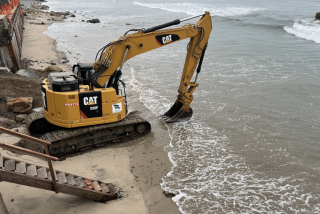Coastal Panel Questions Residents’ Preferred Parking
- Share via
SEAL BEACH — The locals in the Old Town section of Seal Beach, a quaint seaside area where stores and cafes really do dot a place called Main Street, face a threat to their way of life.
The treasured, residents-only parking sticker may be in jeopardy.
The way the California Coastal Commission sees it, the shoreline belongs to everyone. That means the right to park near enough to walk there. But for residents of this town, that would leave them circling their own streets looking for a place to unload the groceries. Just try to park within a mile of the beach on a Saturday in August, they say. It won’t happen.
The Coastal Commission recently began an investigation to determine if the city’s parking permits are legal. College interns were dispatched to survey the parking situation so that commissioners can decide whether action is warranted.
The $10 decals allow all Seal Beach residents to ignore the one-hour-only signs in Old Town, the neighborhood south of Pacific Coast Highway.
The same issue has arisen in Santa Monica, where the Coastal Commission will consider an application for permit parking, and in Long Beach, where the commission turned one down.
“We consider public access a very important issue,” said Teresa Henry, director of the commission’s Southern California headquarters in Long Beach. “The question is: Does the public have the right to park adjacent to the beach?”
The 1976 Coastal Act establishes that right, but also gives the commission the authority to allow some permit parking. Seal Beach’s permit parking law predates the act, and the commission is trying to determine whether the law should be grandfathered in.
When the city was incorporated in about 1915 and Old Town had yet to earn its name, no one foresaw that parking would be at such a premium, assistant city manager Dan Dorsey said. Some houses and apartments don’t even have carports.
“Parking was a snap in those days,” he said.
Now, Seal Beach residents say, they can’t imagine the situation without permits.
“Shouldn’t you be allowed to park within some proximity of your home?” said former City Councilwoman and Old Town resident Marilyn Bruce Hastings.
All-day parking is offered at two free lots on Main Street and two pay lots at the beach. Still, it’s hard to accommodate the throngs of daily visitors, Dorsey said.
Santa Monica has the same problem. That city has asked the commission to allow it to keep its resident-only parking in heavily congested areas, mostly south of the pier.
“We do have preferential zones, established in the early ‘80s, for which we did not seek Coastal Commission approval,” said Andy Agle, deputy director of planning. “At that point, the Coastal Commission attorney told our staff it would not be required. In June, we got a notice of violation that those zones have not been properly permitted.”
Commissioners are expected to review the application this fall.
In Long Beach, residents in the Belmont Shore area lost a 1997 bid for permits near a local spot known as Mother’s Beach.
“Someone said, ‘Why are you allowing it in Seal Beach and not allowing it here?’ ” Henry said. “And we said, ‘We’ll be investigating.’ ”
More to Read
Sign up for Essential California
The most important California stories and recommendations in your inbox every morning.
You may occasionally receive promotional content from the Los Angeles Times.










